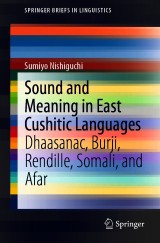Details

Sound and Meaning in East Cushitic Languages
Dhaasanac, Burji, Rendille, Somali, and AfarSpringerBriefs in Linguistics
|
53,49 € |
|
| Verlag: | Springer |
| Format: | |
| Veröffentl.: | 22.01.2021 |
| ISBN/EAN: | 9789811569722 |
| Sprache: | englisch |
Dieses eBook enthält ein Wasserzeichen.
Beschreibungen
<div>This book, one of the few English language publications on indigenous languages spoken in East Africa, highlights theoretical contributions on understudied East Cushitic languages, based on extensive data. It introduces readers to important fields such as the OT phonology and morphology of Dhaasanac and discusses the syntax of negation, semantics of focus, negation and context shift. It then examines negative polarity items and context sensitivity in the Rendille, Burji, Somali and Afar languages to offer broader insights into these phenomena. Given its focus, the book will appeal to researchers and students who are interested in formal semantics, pragmatics and indigenous studies around the globe, especially those wanting to learn about East Cushitic linguistics. <br></div>
<div>1 Phonology<br></div><div>Consonant Assimilation and Sonority in Dhaasanac </div><div>1.1 Introduction <br></div><div>1.2 CC Sequences within Morphemes </div><div>1.3 CC Sequences across Morpheme Boundaries </div><div>1.4 Consonant Assimilation and Deletion </div><div>1.5 Summary </div><div>2 Bimoraic Filter and Sonority in Dhaasanac Imperfective </div>2.1 Imperfective Paradigm <div>2.1.1 Simple -a Suffixation </div><div>2.1.2 Nasal Extension </div><div>2.1.3 Vowel Lengthening </div><div>2.1.4 Vowel Lengthening and Nasal Extension </div><div>2.1.5 Vowel Shortening and Nasal Extension </div><div>2.1.6 Reduplication </div><div>2.1.7 Vowel Shortening and Reduplication </div><div>2.1.8 Summary </div>2.2 Dominant Constraints in Dhaasanac <div>2.2.1 Partial Reduplication and Compensatory Gemination . </div><div>2.2.2 Progressive Vowel Harmony </div><div>2.2.3 Nasal Extension </div><div>2.2.4 Vowel Lengthening Due to Moraic Foot Binarity . . . . </div><div>2.3 Sonority Sensitive Syllable Contact Law </div><div>2.4 Conclusion </div><div>II Morphology <br></div><div>3 Imperfect in Dhaasanac and OT Morphology </div><div>3.1 Prosodic Morpheme and Allomorphy </div><div>3.1.1 Prosodic Morpheme </div><div>3.1.2 Prosodic Morpheme of Dhaasanac Verbs and Allomorphs </div><div>3.2 Phonologically Unpredictable Allomorphy </div><div>3.2.1 Multiple Underlying Representations? </div><div>3.2.2 Unpredictable Allomorph Selection </div><div>3.3 Lexical Specification and Implication to Word-Based Morphol- </div><div>ogy </div><div>3.3.1 Diacritic Features </div><div>3.3.2 Word Based Morphology </div><div>3.4 Constraints as Abstracted Morphemes: Word-Based OT . . </div>3.4.1 OT Morphology <div>3.4.2 Word Based OT Morphology </div><div>3.5 Conclusion </div><div>III Syntax </div><div>4 NPI Licensing in Dhaasanac </div><div>4.1 NPI Maa </div><div>4.2 NPI Niini </div><div>4.3 Agree </div><div>4.4 Reverse Agree </div><div>4.5 Niini and Maa Licensing as Reverse Agree </div><div>5 Double Negation and NPI Licensing in Dhaasanac </div><div>IV Semantics </div><div>6 Metalinguistic Negation in Dhaasanac </div><div>6.1 Focus Equivalent to Another Negation </div><div>6.2 Truth-Conditional Meaning of Focus </div><div>6.3 Pragmatic Account </div><div>6.3.1 Conversational Implicature </div><div>6.3.2 Metalinguistic Negation </div><div>6.3.3 Negation Outscopes the VERUM Operator </div><div>6.4 Peculiarities with Focused Negation in Dhaasanac </div><div>6.4.1 Polarity Reversing Focus in Non-assertions </div><div>6.4.2 Given Foci </div>6.5 Conclusion <div>7 Non-monotonic NPI Licensing in Dhaasanach </div><div>7.1 NPIs in Non-Downward Entailing Context </div><div>7.2 Other Non-monotonic NPI Licensing Context </div><div>7.2.1 At most n </div><div>7.2.2 Only </div><div>7.2.3 Superlative </div><div>7.2.4 Comparative </div><div>7.2.5 Exactly n </div><div>7.2.6 Emotives </div><div>7.2.7 Universal </div><div>7.2.8 Few </div><div>7.2.9 No </div><div>7.3 Conclusion </div><div>7.4 Appendix: Quantifiers in Dhaasanach </div><div>8 NPIs in Burji 97</div><div>9 Monstrous Operators in Dhaasanac </div><div>9.1 Monsters in Indirect Discourse </div><div>9.2 Monsters in Dhaasanac </div><div>9.3 Attitudes Shift Context Parameters </div><div>9.4 Conclusion </div><div>10 Temporal Indexicals in Dhaasanac </div><div>10.1 Three Types of Monsters </div><div>10.2 Indexical Shifting in Dhaasanac </div><div>10.2.1 Person Indexical I </div><div>10.2.2 Indexical Shifting in Relative Clauses </div><div>10.2.3 Person Indexical You </div><div>10.2.4 Reportatives </div><div>10.2.5 Temporal Indexicals Yesterday and Today </div><div>10.2.6 Locative Indexicals </div><div>10.2.7 Fake Past in Simple Sentences </div><div>When Forgotten </div><div>Surprise </div><div>10.3 Analysis </div><div>10.4 Oromo </div><div>10.5 Conclusion </div><div>11 Indexicals in Somali </div><div>12 De Re Indexicals in Afar </div><div>13 Indexicals in Rendille </div>13.1 Optional Shift of Indexicals <div>13.1.1 Optional Shift of Person Pronouns </div><div>13.1.2 Temporal and Locative Indexicals </div><div>13.1.3 Other predicates than tell or say </div><div>13.2 Analysis </div><div>14 All-shift Monster in Burji </div><div>14.1 Indexicals in Burji </div><div>14.2 Monster vs Binding Approach </div><div>14.3 Conclusion </div><div>14.4 Appendix A: Glossaries </div><div>14.5 Appendix B: Grammar </div><div><br></div>
<p>Sumiyo Nishiguchi is an Associate Professor at the Center for Language Studies, Otaru University of Commerce. As a conference committee member of the English Linguistics Society of Japan, she has been leading the progressive field of linguistics since 2019. </p><p>She holds a Ph.D. in Language and Culture (2010) and M.A. in English Linguistics (2003) from Osaka University, Japan, as well as an M.A. in Linguistics from the State University of New York, Stony Brook (2007). She has pursued research as a Junior Associate Professor at the Faculties of Science Division I and Management, Tokyo University of Science (since 2011), and as an Assistant Professor at the Center for International Cooperation in Engineering Education, University of Tokushima (since 2009). Her research interests include formal semantics, formal pragmatics and syntax. In the past 5 years, she has successfully accomplished a project with JSPS KAKANEHI on indexicality and negation in Dhaasanac and Somali languages. She is the author of 8 books and collected volumes and has published over 80 articles in national and international journals.</p>
This book, one of the few English language publications on indigenous languages spoken in East Africa, highlights theoretical contributions on understudied East Cushitic languages, based on extensive data. It introduces readers to important fields such as the OT phonology and morphology of Dhaasanac and discusses the syntax of negation, semantics of focus, negation and context shift. It then examines negative polarity items and context sensitivity in the Rendille, Burji, Somali and Afar languages to offer broader insights into these phenomena. Given its focus, the book will appeal to researchers and students who are interested in formal semantics, pragmatics and indigenous studies around the globe, especially those wanting to learn about East Cushitic linguistics.
<p>Provides novel data on understudied East Cushitic languages</p><p>Presents an insightful new analysis of context change</p><p>Explores the reasons why “no” sometimes means “yes”</p>

















